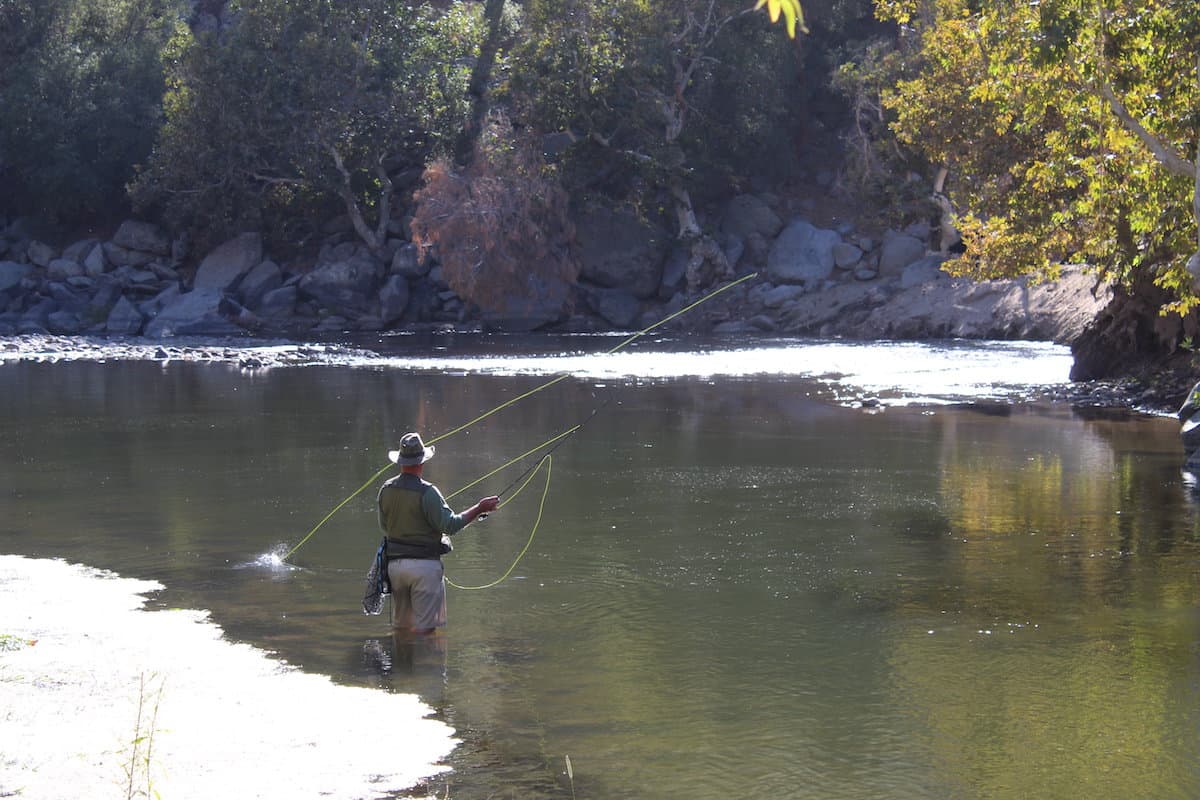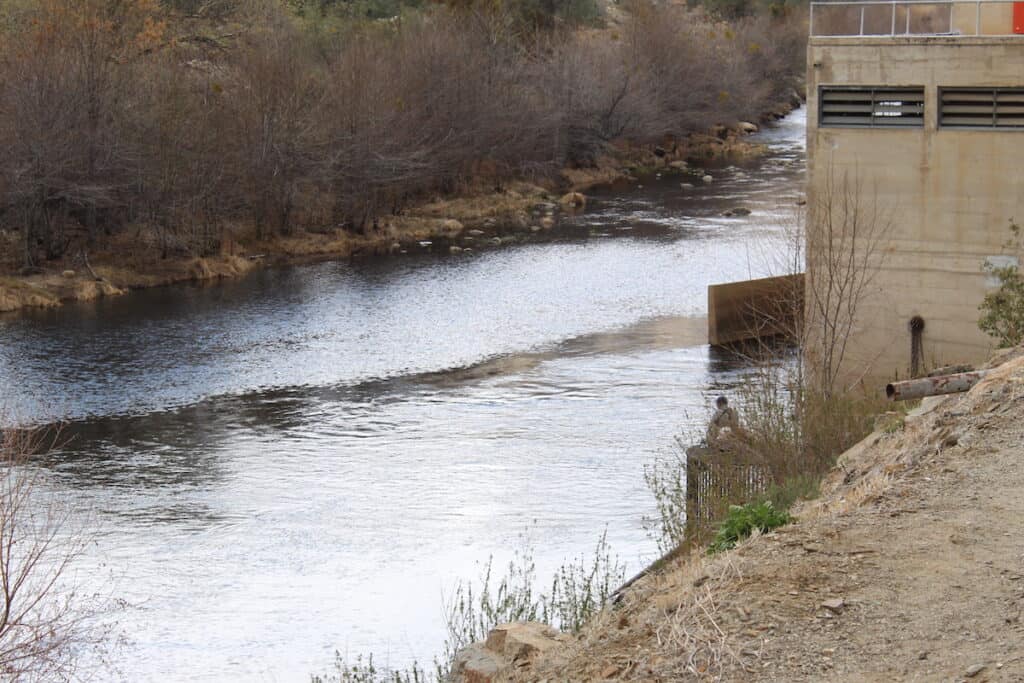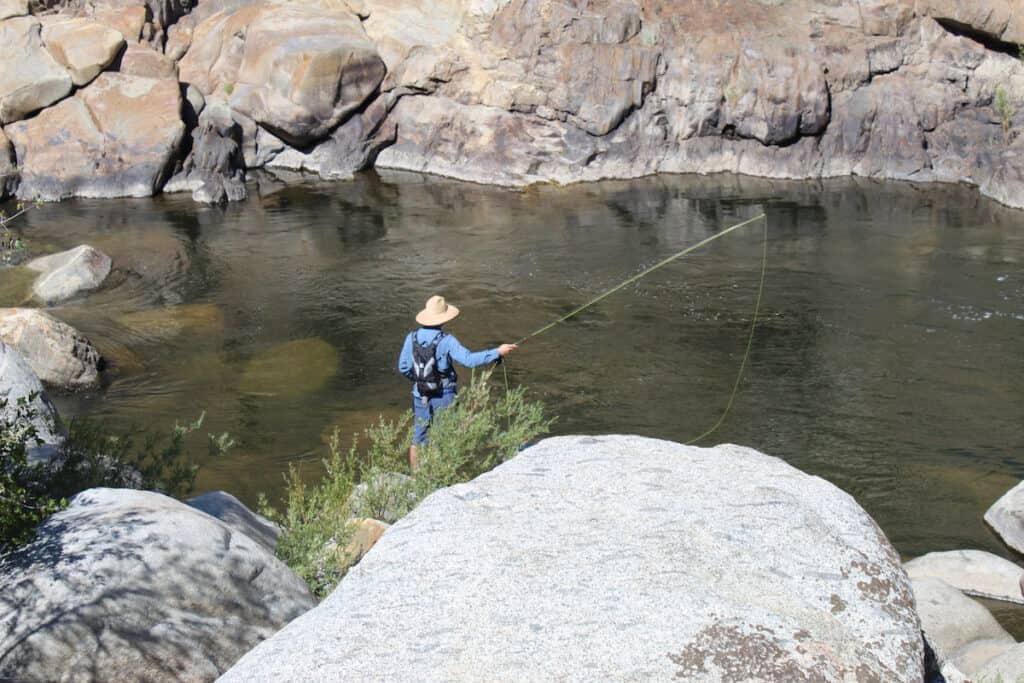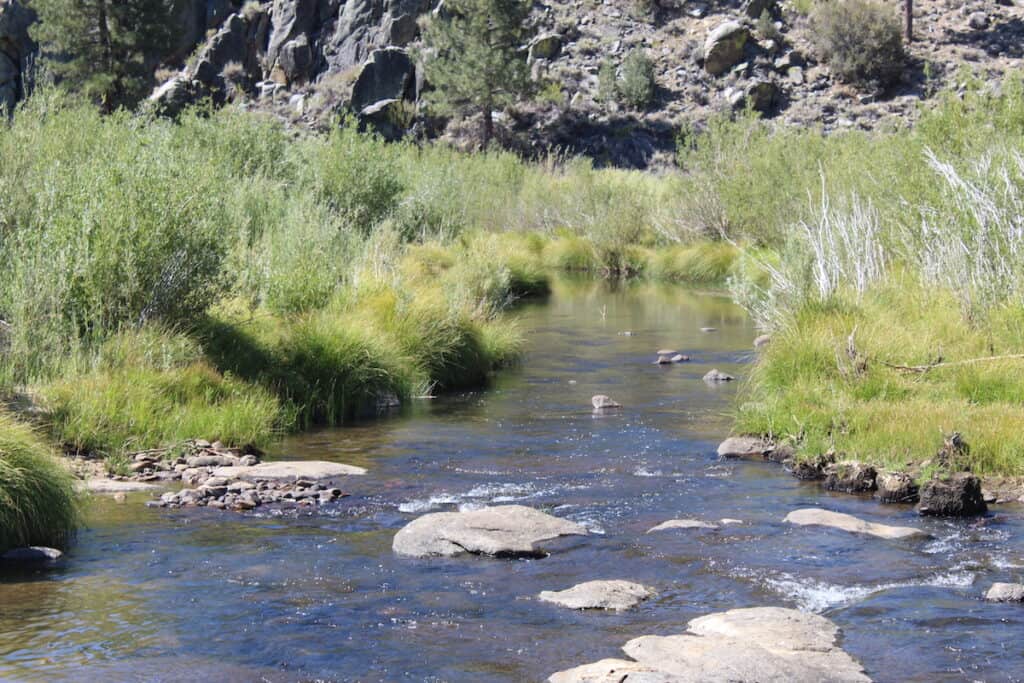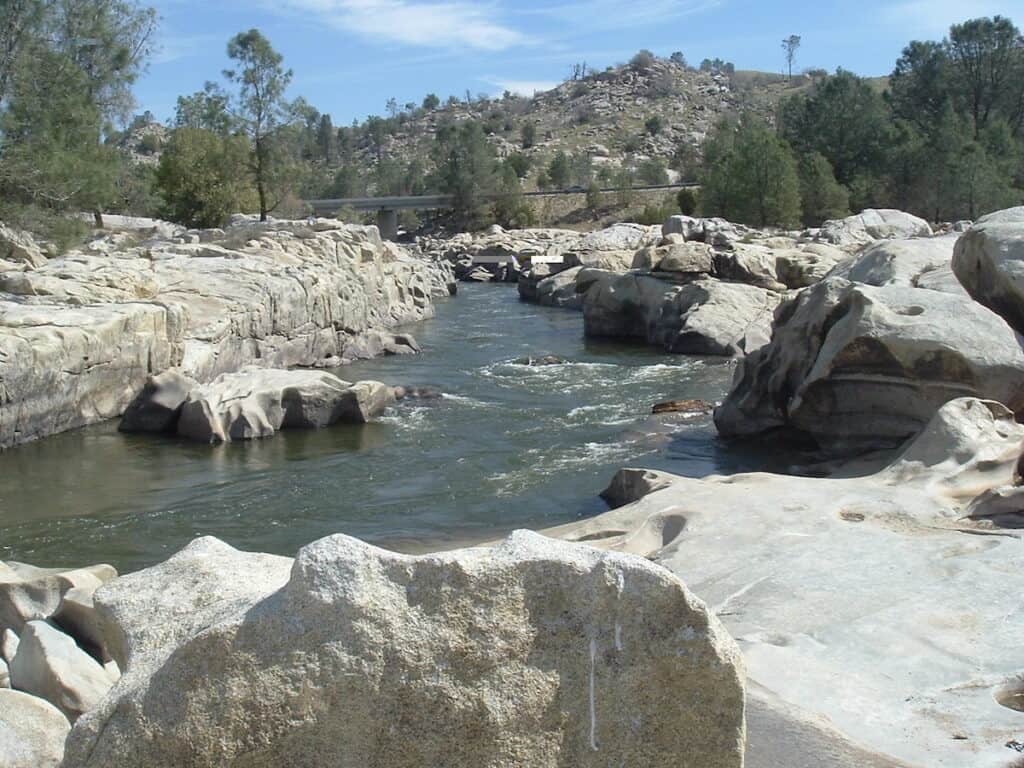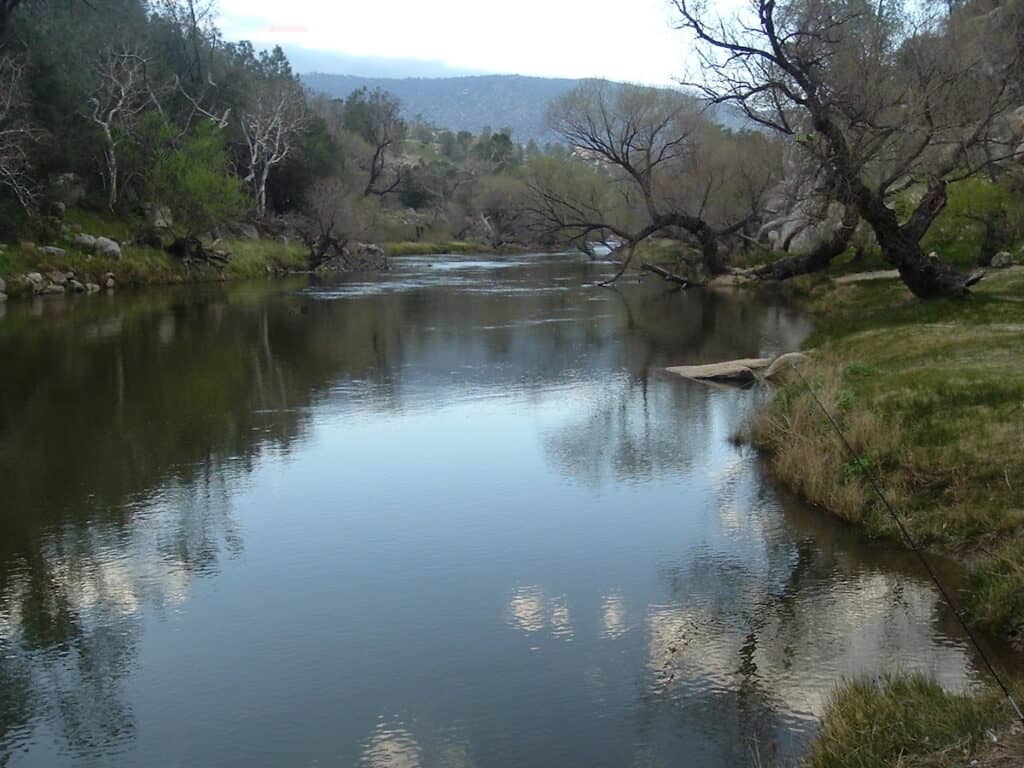The Kern River is an incredibly beautiful and productive trout fishing stream flowing through the southern Sierra Nevada Mountains.
From its headwaters on Mt. Whitney, the Kern flows through the Sequoia National Forest and forms Lake Isabella and smaller lakes on its way down to Bakersfield.
Depending on where you fish it, the Kern will provide you with easy action for stocked rainbow trout or more challenge in catching wily wild fish.
Lower reaches of the river hold nice populations of warmwater fish to catch, including bass and catfish.
Why Fish the Kern River?
Unlike the Eastern Sierras, the Kern River Valley is smaller, less crowded, and full of fighting fish. However, there are many different sections of the Kern River to fish that it can be daunting.
However, I’m a local angler here to show you the best spots and techniques to have a great day or week fishing the Kern River.
For our purposes here, we’ll divide the Kern River into three main parts:
- The Lower Kern River below the dam at Lake Isabella all the way downriver past Bakersfield
- The Upper Kern River above Lake Isabella stretches about 20 road miles from Kernville upstream to the Johnsondale Bridge
- Wild Trout section in the remote hike-in area above Johnsondale Bridge
Numerous tributaries feed the Kern River as well. For example, the South Fork of the Kern River meets the North Fork at Lake Isabella.
The South Fork flows mainly through the Kennedy Meadows area down the mountain to the lake and is home to native and stocked trout.
The Little Kern River flows into the North Fork of the Kern River in an area known as the “Forks of the Kern” and is only accessible by foot.
A well-known and well-used trail that requires an overnight camping permit from the National Forest Service accesses the Forks area.
The North Fork area is known as the Golden Trout Wilderness. See below for more information.
Upper Kern River Fishing
Upper Kern River Fish Species
The parts of the Upper Kern River that are accessible by vehicle may hold rainbow and brown trout, pikeminnow, carp, and sometimes smallmouth bass that migrate up from Lake Isabella.
The fish found upstream from Johnsondale Bridge are primarily native Kern River rainbow trout, although golden trout can be found in some tributaries in the watershed.
Fishing the Kern River near Kernville
The Kern River really starts to shine when it flows through the small town of Kernville, just a few miles upstream from Lake Isabella.
Here the trout stocking program is very generous, and that draws a lot of people.
This part of the river includes plenty of moving water punctuated with deep pools where the fish often congregate.
The best tactic I’ve found for this area is keeping your rod tip up and using salmon eggs, nightcrawlers, jigs or flies.
The best place to fish in the river right in Kernville is Riverside Park. Besides fish in the stream, you’ll find free parking, a playground, barbecue grills, restrooms, and plenty of places to eat nearby. It’s a very family-friendly environment.
Kern River Fishing Spots Farther Upstream
Once you cross the bridge in Kernville, you are on your way upriver. Mountain 99 is the main road that leads you there. This route will bring you past some terrific fishing spots.
One very special place to fish is Power House Three, located just a few miles from Kernville.
When you are heading uphill and see the now-closed trout hatchery, slow down and look for a Southern California Edison sign. Turn left (west) and follow the road to the parking lot below the Power House.
This is a great spot to wade, bait fish, and explore. I consider this location a must-stop spot for fishing this stocked area. If you can’t seem to find it, just ask at any of the local shops nearby.
Power House Three is a special place because it discharges water back into the river after going through the hydrogenator plant.
This artificial structure seems to help anglers catch more fish. During low water events, you can wade in the river close to the discharge area and cast into and up against the concrete wall.
The wall and discharge tunnel form a very deep pool of semi-fast-moving water. Where this wall funnels the water current back into the main river forming a natural feeding zone for the trout.
More Upper Kern River Fishing Spots
Continuing north on Mountain 99, you will notice how the road hugs the Kern River all the way to the parking lot at Johnsondale Bridge. There are so many turnouts to park and fish in the river all the way up to the bridge.
One very good fishing spot is McNally’s Burger Stand, where they serve great food and offer a footbridge to cross the river.
The California Department of Fish and Wildlife (CDFW) provides generous numbers of trout all summer long at this spot.
Fairview Campground is right next to McNally’s and offers a small parking area. This is the unofficial halfway point to the special regulations fishing area.
If staying in the area, you can easily plan your fishing destinations one day at a time. With on-stream parking areas, small turnouts, dirt roads leading out into the hills, and so much more to explore, you couldn’t fish every good spot in just one weekend.
Campground Fishing Locations
There are at least 20 different campgrounds and about a half dozen free disbursed camping areas all along the Upper Kern River.
All have river access, and most privately owned campgrounds will charge a day-use fee if you want to fish in that area.
Parking along the riverbank is a great option to explore most of the river mainly because it is free parking and right on the river. The farther you go upstream, the more fishing opportunity you have.
Upper Kern River Fishing Tactics
The most successful tactic used for fishing the Upper Kern River for me, by far, is using artificial salmon eggs on a drift-style rig.
Use a number 6 size or smaller hook tied to the bottom of your leader or line. Then pinch or tie on a ⅛-ounce weight about 18-24 inches above the hook.
Hook on the salmon egg artificial bait and let it drift with the current, holding your rod tip up the whole time to avoid getting snagged. Since almost all the trout in this section are stocked, they react very well to salmon eggs.
As your line starts to get tight at the end of the drift, simply reel it in and start the drift process all over again.
This is a very effective method to fish moving water that is stocked with trout. You can substitute a piece of nightcrawler, redworm or other bait of choice with the appropriate-sized hook.
In this Upper Kern River area, you might occasionally catch native Kern River rainbow trout and wild trout that are the offspring of the stocked trout from years past.
While stocked trout can’t move upriver, the natives can pass barriers in the river heading downstream, especially during high-water years.
These fish have a very different color scheme to them than stocked trout. If you look closely, you can still see the remaining parr markings from when they were hatchlings.
Catch More Trout
Check out our comprehensive guide to trout fishing techniques for more tips and tactics.
Kern River Fly Fishing
When it comes to fly fishing, the Upper Kern River is one of the best areas to fish for stocked trout in this part of California.
These hungry, pen-raised fish react very aggressively to natural-looking food.
Unlike their wild kin, they have not developed a keen sense of surviving in the wild. Therefore, they will hit most flies if presented properly.
The most effective ways to fly fish in this section include nymph fishing, fishing a dry fly with a dropper, or drifting a fly.
Drift fishing with a strike indicator allows the current to bring the fly to the fish naturally, which won’t alert the fish to danger and leads to better fishing success.
The best overall setup for drift fishing is tying on a small midge like a Blood Midge 24 to 36 inches up from the bottom, and a bigger emerger fly like the Kern Candy on the bottom. Then, add a strike indicator 36 inches or more from the midge.
However, with fly fishing, you really must be in the water to cast effectively to the fish.
That said, the tricky current and slippery rocks will give you a hard time wading out there. When wading the Kern River, it is always best to go in pairs, and have all your safety equipment ready and working.
Gear including waders, a good pair of wading boots, a wading belt to keep the water from filling your waders if you slip and fall, a good strong wading staff, and even a personal flotation device (PFD vest) are all good ideas.
Even though the Kern River is a wonderful river full of beautiful locations, it still has a strong current.
Kern River Special Regulations Area
The Johnsondale Bridge parking lot is the farthest you can drive alongside the Kern River. This bridge marks the start of the Wild Trout Special Regulations Area.
The trail leading down to the river is not for the faint of heart. Very steep stairs take you down to the trailhead. Here you will see the description of the Special Regulations Area, and they are strictly enforced.
The trail itself is easy to moderate, very busy in the summer, and full of day hikers from all over the world.
As far as fishing access goes, this section of the river can be more rugged with steep banks to get within casting range.
There are so many access points from the trail it will take you a lifetime to explore them all.
The best advice from a local fly-fishing guide, Guy Jeans at the Kern River Fly Shop, is to simply hike in about a mile before you even think of stopping because spots beyond a mile are seldom fished.
You can find out more fly-fishing information from Guy by visiting the Kern River Fly Shop’s website.
Since this area has special regulations, you cannot fish with bait of any kind. Only lures or flies with barbless hooks may be used.
While this type of fishing is difficult for some novices, it’s a welcome challenge for the most serious anglers. The tactics of throwing on a fat nightcrawler or PowerBait are behind you when you head up this trail.
These waters hold an impressive amount of good size healthy fish mainly because the anglers that fish this section practice catch and release with these native trout.
These full-bodied, vibrant-colored Kern River rainbows are used to thriving in current and fight like there is no giving up. And they are a work of art to look at. You can learn more about these wild rainbows at this CDFW website.
Why So Special of an Area?
For those up to the task, this is the most exciting part of the river to fish due to its remoteness and giant wild trout. The Kern River rainbow calls this water home, and this reach is part of the California Wild Trout Heritage Program.
And it’s a must-do for any serious trout angler.
With this area being the last area to gain access to by vehicle and without a very long hike and overnight stay, it is by far the most scenic area to visit. I consider it a great destination day trip while visiting the Kern River.
The natural obstacles that form a barrier prevent the stocked trout from migrating upstream. Native Kern River rainbows thrive up here.
Fishing the South Fork Kern River (Kennedy Meadows)
Flowing out of the 304,000 acres of the Golden Trout Wilderness, the South Fork of the Kern River is a wonder all its own.
Flowing through the famed Monache Meadows off-road trail area, this little stream is filled with wild trout. California golden trout abound in these regions, while the Kern River rainbow is the most common fish you’ll catch.
Trout don’t often get very large in these smaller streams at high elevations. However, you still come across some that simply defy logic on how they got that big.
There are no special regulations in place at all in these areas, even for the golden trout.
Most anglers park at the bridge before the Kennedy Meadows Campground and fish either upstream or downstream. Both areas are stocked in the spring and summer, so your chances are pretty good.
Going toward the campgrounds, numerous turnoffs provide disbursed camping and day use. There is a fair amount of offroad vehicle use, mainly motorcycles. However, they stick to the marked trails, which are away from the fishing spots.
Do your research before going to these areas due to changes in weather, fire, and road conditions.
This is a very busy place in the summer and fall, and it often gets down to near freezing at night, even in the summer. Always be prepared when out in this area because you are indeed in the wilderness.
One very popular, moderately strenuous hike is to the Kennedy Meadows Bridge, which is upstream a few miles from the campground. Built for the Pacific Crest trail that makes its way through here, it is a great spot to try your luck fishing.
There is also The General Store just away from the bridge. Here you can grab something to eat, talk to the PCT hikers often resting there, pick up some supplies, and pet the dogs that are part of the family at the store.
Overall, this is a great place within the Kern River area to spend the day, the weekend, or even longer.
You’ll need a free U.S. Forest Service permit to stay overnight in the Golden Trout Wilderness.
More: Complete Guide to Fishing at Kennedy Meadows (South Fork Kern River)
Fishing the Lower Kern River
Now let’s talk about fishing the river below Lake Isabella, which still offers a chance to catch trout but also a mixed bag that might include bass, catfish and panfish.
Fish Species of the Lower Kern River
Besides Lake Isabella itself, which is a premier fishery in its own right, the Lower Kern River has the most diversity of fish species in the watershed. Smallmouth bass, largemouth bass, trout, crappie, carp, pikeminnow, channel catfish, bullhead catfish, flathead catfish, bluegill, and sunfish are all in the Lower Kern River.
In addition to stocked rainbow trout, the most sought-after fish in the Lower Kern River are resident smallmouth bass. Anglers from all over come here just to try their luck at this very hard-fighting predator.
Fishing tactics for the Lower Kern River below the dam at Lake Isabella are completely different than fishing either the lake or upriver sections of the river.
Here you will find steep canyons, boulder-lined shores, giant rocks, huge gravel bars, and some very deep, slow-moving sections that require caution because of the strong currents.
The CDFW stocks hatchery trout when water conditions permit.
Fishing tactics for trout (which also may catch some bass or other fish) include using jigs or small spinners and drifting bait like nightcrawlers or salmon eggs.
Make sure to fish around midstream boulders and cut banks to find fish just waiting to ambush your offering.
Keysville Special Recreation Area
The Lower Kern River is very hard to figure out because of all the drastic terrain changes all along the river. From super steep canyons to flat, slow-moving and deep water, the river is always changing through here.
One of the most rewarding spots to fish on the Lower Kern River is Keysville Special Recreation Area. This recreation area has a paved road for about 3.5 miles, which is about as far as you want to go if driving any type of RV or towing a bigger trailer.
There are hundreds of free disbursed camping sites, and most have vault-style toilets but no running water. Here you can camp, fish, and kayak until you’re tired. Then simply move to another spot and do it all over again.
Keysville Beach is one area where CDFW often plants trout. Raft Launch #1 is another, and South Keysville Raft launch is a third.
Another area that trout are stocked on the Lower Kern River is Delonegha Raft Launch and Takeout Area. This is a very nice area and is really popular in the summer. You will find good water, good current, lots of deep pools, and tons of fish species.
Farther downstream is Democrat Day Use Area. Sometimes trout stocks go in here as well, depending on water temps.
Lower Kern River Fishing Tactics
As mentioned above, salmon eggs, nightcrawlers, spinners and jigs are mainly used for stocked trout.
The overall best tactic for trout is bait fishing, drift fishing, and casting lures such as Kastmasters, Rooster Tails, and Panther Martins.
However, Kern River bass fishing is another excellent option. The lower Kern is well-known for its smallmouth bass population and the challenges these fish offer.
If going after the bass, try something more enticing to eat. Small crankbaits work very well in the confined spaces on the Lower Kern. Creature baits like small lizards and even mice are a great way to pick up the bigger bass.
We have lots more bass fishing techniques and tips in our how-to guide.
Live bait works best when you want to try for any fish species that will bite, and a lively nightcrawler is the number one ticket to catching fish in this section.
Drifting a nightcrawler is the same tactic as drifting salmon eggs we talked about for the Upper Kern. Tie your hook on the bottom and add a split shot about 18-24 inches above the hook and bait it. Cast out and keep the rod tip high to avoid snags as you complete the drift.
The best place to try drift fishing is before any natural obstacles like a chain of rocks crossing the river, along a deep-sided sand bar, or behind and in front of large boulders and rocks.
Let the current drift the live bait toward these natural holding spots, and be prepared for the fast strike.
Live minnows are another all-around bait for catching multiple species, and the best place to fish with them is in deeper, slower-moving water.
Planning Your Trip
There are a few ways to get to this area from most of Southern California.
Starting on the Lower Kern River, coming up from Bakersfield on State Route 178, you will drive through one of the most scenic river canyons you can ever think of. The river flows all along the road leading up to Lake Isabella.
This section of the river is considerably warmer than the upper river. Full of swift water, rapids, rafting, hot springs, picnic areas, and day-use facilities.
The route through the desert is the same as going to Mammoth or Lee Vining, except you go southwest at the split of Highway 14 and 395. Highway 14 will lead you to State Route 178, and into the Kern River Valley. Here you will pass one of the biggest Joshua Tree forests around.
Where to Stay
On the Upper Kern River, there are over 20 different campgrounds, numerous hotels, and a host of Airbnb rentals available. There’s even a vast amount of disbursed camping areas, so anglers and their families will always have a place to call base camp.
For a complete list of Upper Kern River campgrounds, see this U.S. Forest Service webpage.
On the Lower Kern River, there are a few overnight camping areas. Among them, Sandy Flats and Hobo campgrounds are operated by a private concessionaire and part of the National Forest.
Black Gulch Disbursed Campground and Keysville Special Recreation Management Areas have free disbursed camping.
For more information or to make reservations simply go to this Forest Service page.
Kern River Fishing Report
The Kern River Fly Shop has a paid subscription “premium fishing report” that covers fly fishing in the Kern River as well as a few other select fisheries.
For free reports, try the Kern River Fly Fishers Club, which posts fairly regularly when there’s info to pass along.
Facebook groups may also be useful when you’re looking for updates. The Kern River Fishing Report page seems to be active for the river and Lake Isabella.
Find More Fishing Near Bakersfield and Kern County
Find More Fishing Near Sequoia National Park and Tulare County

